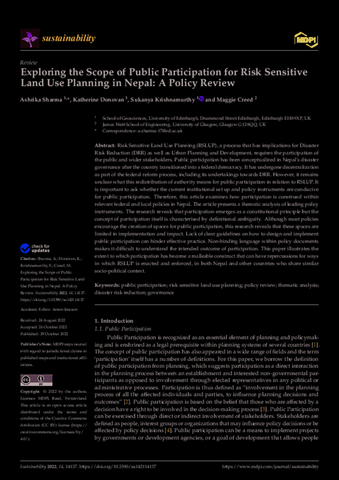Risk Sensitive Land Use Planning (RSLUP), a process that has implications for Disaster
Risk Reduction (DRR) as well as Urban Planning and Development, requires the participation of
the public and wider stakeholders. Public participation has been conceptualized in Nepal’s disaster
governance after the country transitioned into a federal democracy. It has undergone decentralization
as part of the federal reform process, including its undertakings towards DRR. However, it remains
unclear what this redistribution of authority means for public participation in relation to RSLUP. It
is important to ask whether the current institutional set up and policy instruments are conducive
for public participation. Therefore, this article examines how participation is construed within
relevant federal and local policies in Nepal. The article presents a thematic analysis of leading policy
instruments. The research reveals that participation emerges as a constitutional principle but the
concept of participation itself is characterised by definitional ambiguity. Although most policies
encourage the creation of spaces for public participation, this research reveals that these spaces are
limited in implementation and impact. Lack of clear guidelines on how to design and implement
public participation can hinder effective practice. Non-binding language within policy documents
makes it difficult to understand the intended outcome of participation. This paper illustrates the
extent to which participation has become a malleable construct that can have repercussions for ways
in which RSLUP is enacted and enforced, in both Nepal and other countries who share similar
socio-political context.
